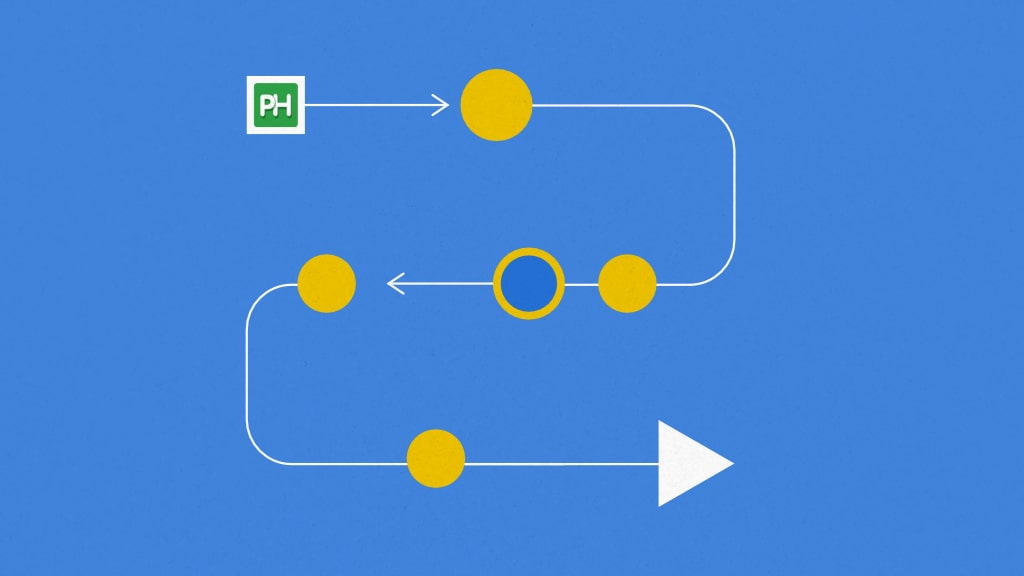Efficiency is the key to the success of an organization and at the heart of efficiency lies workflow management—a strategic approach to tasks, processes, and resources. An organization faces various challenges that can hinder its efficiency and growth. From tiring manual processes to disjointed communication channels, the obstacles are endless.
Luckily, in today’s tech-driven world, there is workflow management software that lets you handle multiple tasks by streamlining all business processes.
An efficient workflow management system helps an organization handle its daily workflow, campaigns, internal projects, and tasks.
What is workflow management and why it is so important?
Workflow management is the process of identifying, organizing, and coordinating a set of tasks to achieve a particular result. It requires optimization, improvement, and automation of daily workflow to increase output, eliminate repetition, and minimize errors. Using workflow application software can make it easier for you to achieve the desired result.
Now, let us understand why having an efficient workflow management system is important.
What is workflow management software?

Workflow management software is an advanced platform that provides flexible tools to improve the way you work. It gives you the ability to create and optimize workflow in an ideal way, find redundant tasks, automate work processes, identify potential areas of improvement, and achieve new levels of efficiency.
When you are in the market for a work management tool, look for a product that allows you to:
- Manage work the way you want
- Create custom workflows
- Make task management easy
- Define stages and move tasks into stages
- Integrate workflow with every task list
- Streamline repetitive processes
- Allow creating and assigning tasks
- Create stages in which tasks can be defined and moved
- Synchronize tasks in every stage
- Follow up on tasks in the process
- Adapts to changes along the way
and much more.
List of top 22 workflow management software
1. ProofHub
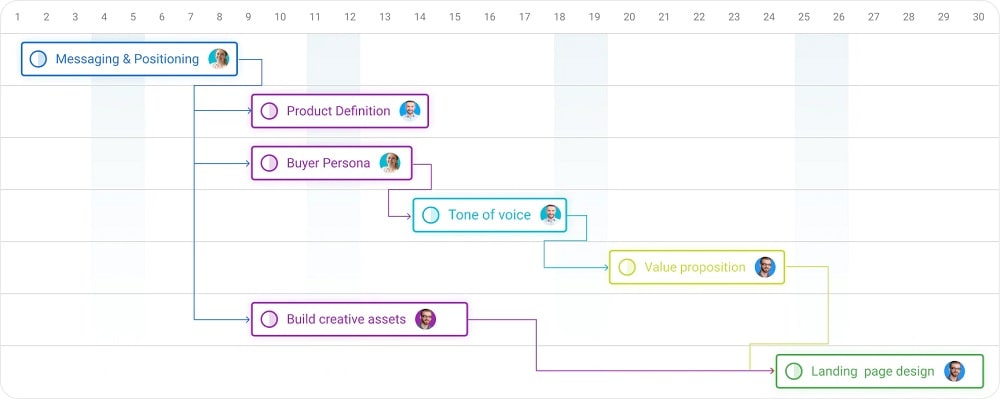
ProofHub is an intuitive project management tool for businesses and teams of all shapes and sizes.
From project planning to collaboration to project progress tracking, and to the final project completion. ProofHub is there to ease daily task management!
That’s not all! Want to know the best part?
You get all of this in one place! No more switching between multiple tools to manage daily tasks!
So, whether you are a project manager or a project team member, ProofHub will help you manage daily tasks with ease. But, what is it that makes ProofHub one of the best workflow management software? Let’s find out.
Why use ProofHub?
The best part about ProofHub is that it works for any business or team. That means whether you’re part of a small team or a large enterprise, you can trust ProofHub to help you bring sanity to your projects, teams, and communications.
In addition to that, here are a few good reasons why you should consider ProofHub as your best option in terms of workflow management.
With ProofHub, you can:
- Get a clear view of work in progress in a particular workflow with Kanban boards in ProofHub.
- Divide tasks into workflow stages, decide who works on what part, and see work moving through multiple stages.
- Create custom labels to differentiate, prioritize, and organize tasks.
- Create task lists, add tasks/subtasks, subscribe the entire tasklist or assign its tasks/subtasks to one or multiple people in one place.
- Share ideas, inputs or feedback on a specific task via comments.
- Attach files from your computer, Dropbox, Google Drive, OneDrive, and Box to the tasks.
- @Mention people in comments, discussions, and group chats to grab their attention or loop them in on tasks.
- Check the progress percentage of tasks to get a clear view of how much work is done and how much is left.
- Create custom reports to get a clear idea of the number of tasks in each stage and how work is progressing.
ProofHub Pros
Given below are some amazing reasons why you should choose ProofHub for daily task management.
1. Offers customized workflow
As a project manager, you need efficient planning to not only plan but also execute projects.
For some project managers, this can mean creating a workflow with just three stages – To-do, doing, and done. However, in others, it requires multiple reviews before the task is sent to the client.
ProofHub gives you the option to create a customized workflow to suit the team’s needs.
It also lets you keep track of how a task moves from one stage to the next. Doing this ensures that all team members are on the same page.
2. Helps with task automation
Does your team work on the same tasks day in and out? Tired of assigning the same work again and again?
ProofHub can ease this for you with efficient task automation through recurring tasks and forms.
All you need to do is create the task once, set the due date, choose repeat, and you are good to go.
3. Offers time tracking
Do you know the biggest hurdle to managing a big team and multiple projects? It is not being able to keep track of task deadlines.
ProofHub lets you set due dates for every task. Team members can also keep track of the time spent on a task manually or with timers.
It ensures that every task is delivered before the stipulated deadline without any compromise on the quality of work.
4. Improves team collaboration
So, your team is working on an important project and it is near completion. But, you sit at a considerable distance from them. It is not practical to get up and give you an update when the project moves to the next stage.
Now, what would be the best way for the team members to communicate this to you? ProofHub has the answer.
All you need to do is add a comment where the project is added, and it is done.
5. Helps with file proofing
Asking an employee to edit a file through email is a cumbersome process.
ProofHub lets you proof files in real time with Online Proofing.
You can collaborate on file, annotate to provide clear feedback, review, and share feedback instantly without any hassle.
6. Offers customized work reports
Which resource is available to work on a project? How many tasks are completed? Why is a specific project taking longer than usual to complete?
You will be able to find the answers to these questions with ProofHub Reports.
ProofHub reports let you generate custom work, resource, and project reports to get insights into a project or resource. You can also see which project is on track, and remain up-to-date about the progress of your tasks, from start to finish.
7. Has multiple views
ProofHub offers four different views to help you keep track of a task’s progress, who is doing what, check for task dependencies, and task milestones achieved.
Board view gives you a bird’s eye view of the tasks organized in a particular workflow. It also helps you check a task’s progress and look for any potential roadblocks. In the Table view, team members can get access to complete information regarding a task with customized fields and handle data with ease.
Gantt charts help you plan and visualize tasks, create task dependencies, and adjust a work schedule as per priorities. The Calendar view helps you check out tasks, project milestones, meetings, deadlines, and upcoming tasks.
ProofHub cons
- Overwhelming notification system
- No Single Google Sign-Ups
Rating
- G2 – 4.5 out of 5. G2 also awarded ProofHub the “High Performer” of 2022.
- Capterra – 4.5 out of 5
ProofHub plans & pricing
ProofHub offers a free trial plan for 14 days. You can also choose from the two subscription plans.
- Essential plan (Costs $45 per month, Flat pricing: No per-user fee)
- Ultimate control (Costs $89 per month, Flat pricing: No per-user fee)
Supercharge Your Productivity with Seamless Workflows. Checkout ProofHub’s potential in its 14-day free trial (No-credit card required)
2. Kissflow
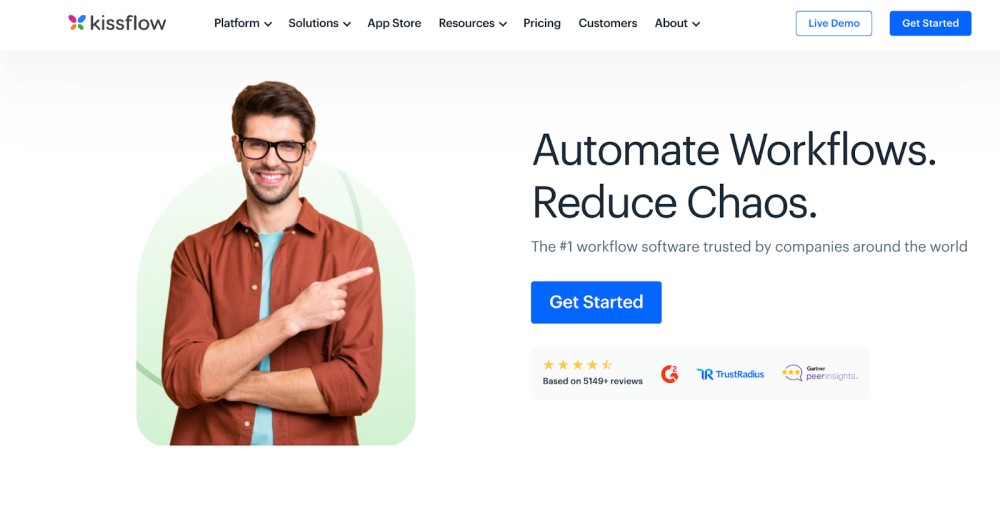
Kissflow offers an easy-to-use and efficient low-code platform ideal for non-programmers and developers. With its automated workflow and business process management, users can easily start from scratch or use pre-built templates for various departments. Its intuitive drag-and-drop form builder and automated notifications streamline data collection and workflow updates. Kissflow’s no-code workflows, project boards, forms, and integrations make it a top choice for automating business processes and building enterprise applications.
Why use Kissflow?
Kissflow enables users to easily create processes with minimal coding, streamlining workflows for improved productivity. It supports governance through customizable roles and permissions, making it ideal for strategies encouraging citizen development among business analysts and Excel experts. With its intuitive interface, Kissflow facilitates collaborative and secure application development, significantly enhancing efficiency within a governable framework.
Kissflow pros
- Low-code process optimization
- Heatmaps
- Custom role-based access
- Custom scripting
- Filters
- Workflow and process automation
- No-code/low-code app development
- Robust integrations
- Case management
Kissflow cons
- No robotic process automation (RPA)
- No Business process model notation (BPMN)
- No process mining
Kissflow rating
- G2 – 4.3 out of 5
- Capterra – 4.1 out of 5
Kissflow pricing
Kissflow offers two subscription plans.
- Basic – Starts at $1,500 per month
- Enterprise – Contact sales for custom pricing
3. Nintex
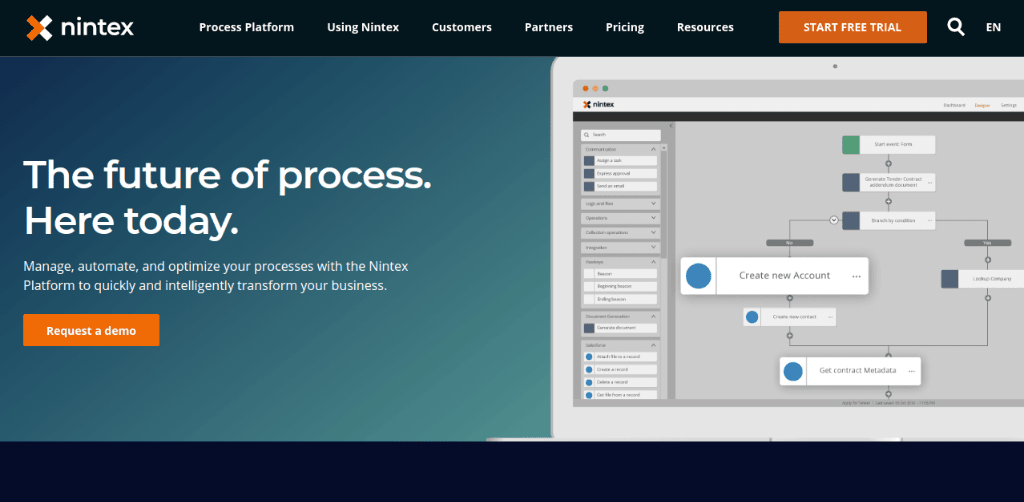
Nintex is a top workflow management software solution for companies. This solution aims to help businesses automate their processes easily and quickly. It helps to automate the processes of widely used collaboration and content management platforms, linking cloud workflows, on-premise systems, and mobile users.
Why use Nintex?
What makes this solution one of the top-rated workflow automation software is the fact that its ease of use. Nintex enables teams to easily streamline work processes, integrate content, and achieve better outcomes. The application provides a people-driven design that is ideal for both everyday processes and complex elaborated procedures.
Nintex pros
- Nintex Gateway
- Data Lookup Control
- Workflow Testing
- Authenticated Tasks
- User Groups
- Web Request Display
- Microsoft Teams integration for Office 365
- Variable management improvements for SharePoint
Nintex cons
- No documentation to understand Nintex
- Takes time to track down errors and fix them
- No support for external data fields
Nintex rating
- G2 – 4.2 out of 5
- Capterra – 4.1 out of 5
Nintex pricing
Nintex offers three different subscription plans. These are;
- Pro – Starts at $25,000 per year.
- Premium – Starts at $50,000 per year.
- Custom – Connect with the Sales team to know the pricing
4. Bit.ai
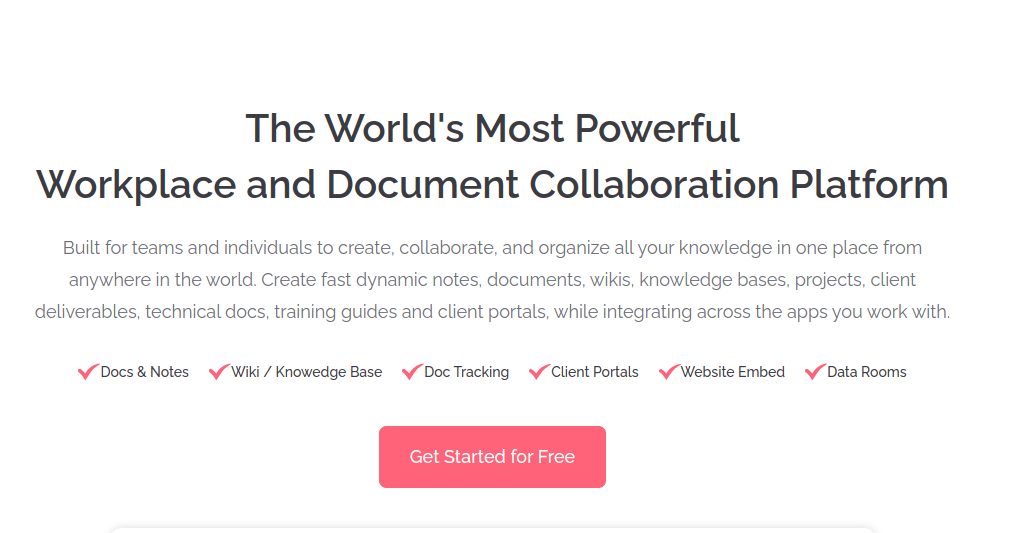
Documents are the lifeblood of a company. Agreements, proposals, plans, contracts, datasheets, designs – every company has an incredible amount of company knowledge it needs to keep track of. Luckily, with software like Bit.ai, you can take your document & workflow management to the next level and set your team up for maximum efficiency.
Why use Bit.ai?
Bit.ai allows you to create, share, manage, organize, and track all company documents and knowledge – under one roof! On this powerful platform, you can create smart workspaces around projects, departments, teams, and clients to keep your data organized. All your documents can be shared (or kept private) with anyone in or outside your organization. Moreover, Bit allows you and your employees to collaborate on the documents in real time.
That’s not it! With Bit, you don’t have to spend hours jumping from one platform to another to find and share the right information. Bit seamlessly integrates with 100+ platforms, including OneDrive, Google Drive, Typeform, Tableau, & Airtable. All these features make this tool the best workflow solution.
Bit.ai pros
- File conversion
- Document generation
- Collaboration tools
- Image editing
- Text editing
- Real-time editing
- Full-text search
- Document templates
Bit.ai cons
- Lack of intuitive UI
- No guided tutorials
- No mobile or desktop app
Bit.ai rating
- G2 – 4.2 out of 5
- Capterra – 5 out of 5
Bit.ai pricing
Bit.ai offers three subscription plans.
- Free
- Pro – Costs $8 per member per month.
- Business – Costs $15 per member per month.
5. ProcessMaker
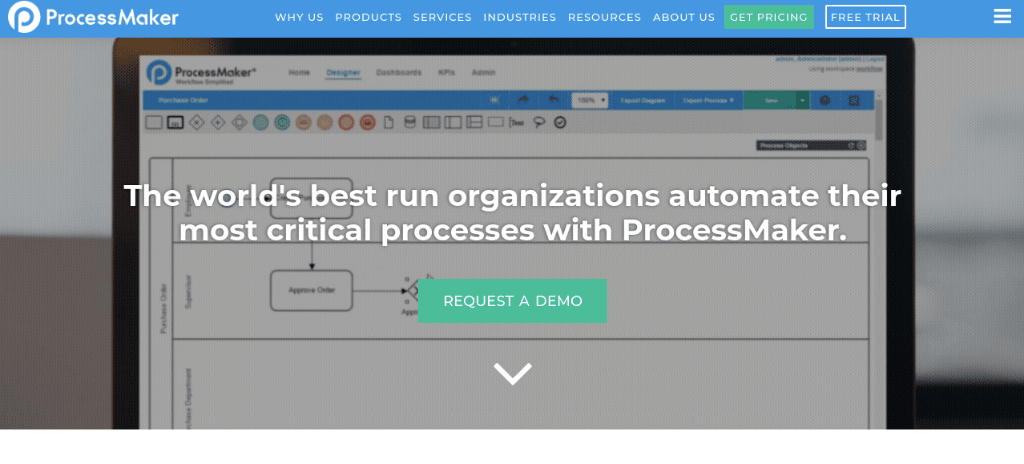
ProcessMaker is an open-source business process management (BPM) and workflow solution. This tool is designed to automate form-based, approval-driven workflow and improve the way information moves between data and systems. It provides an intuitive, drag-and-drop interface that is easy to use and extremely cost-effective.
Why use ProcessMaker?
The quality that makes ProcessMaker an ideal choice for professionals is that it’s lightweight, extremely efficient, and has a low overhead. Today, a large number of business analysts and subject matter experts rely on ProcessMaker for automating workflow, communicating with their teams, and achieving more.
ProcessMaker pros
- Flexible dashboards
- Document and evidence filing
- Case tracking
- Notifications
- Integrated data analytics
ProcessMaker cons
- Compatibility issues with Internet Explorer browser
- Several important features require knowledge of coding
- Hard to understand UI
ProcessMaker rating
- G2 – 4.3 out of 5
- Capterra – 4.5 out of 5
ProcessMaker pricing
ProcessMaker offers two subscription plans.
- Standard – Costs $1, 495 per month.
- Enterprise – Costs $2,479 per month.
6. ProProfs Project
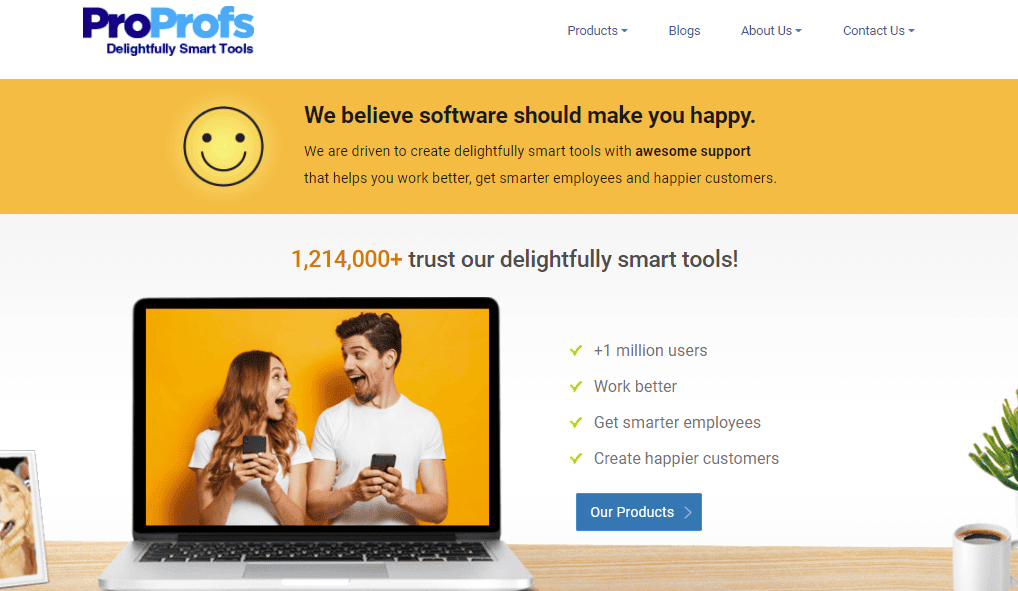
ProProfs Project is a smart process and workflow management software that focuses on work planning and team collaboration to help project managers and teams get to the finish line efficiently. You can easily create custom workflows and visualize the project overview using Kanban boards and Gantt charts. With actionable reports, teams can easily identify bottlenecks to make informed decisions for improvement in performance.
Why use ProProfs Project?
Using ProProfs Project, project managers can delightfully plan, organize, and manage work from a centralized dashboard. The ease of use and other smart features makes this collaborative workflow management platform a good fit for different teams. Moreover, the software has two affordable pricing options for small, medium, and large businesses.
ProProfs Project pros
- Task management
- Gantt charts
- Email integration
- Document management
- Resource management
- Budget & Expense management
ProProfs Project cons
- Weak reporting system
- No workflow automation feature
- UI/UX needs improvement
ProProfs Project rating
- G2 – 4.4 out of 5
- Capterra – 4.7 out of 5
ProProfs Project pricing
ProProfs Project offers two subscription plans
- Monthly – Costs $49.97 per month
- Yearly – Costs $39.97
7. Process Street
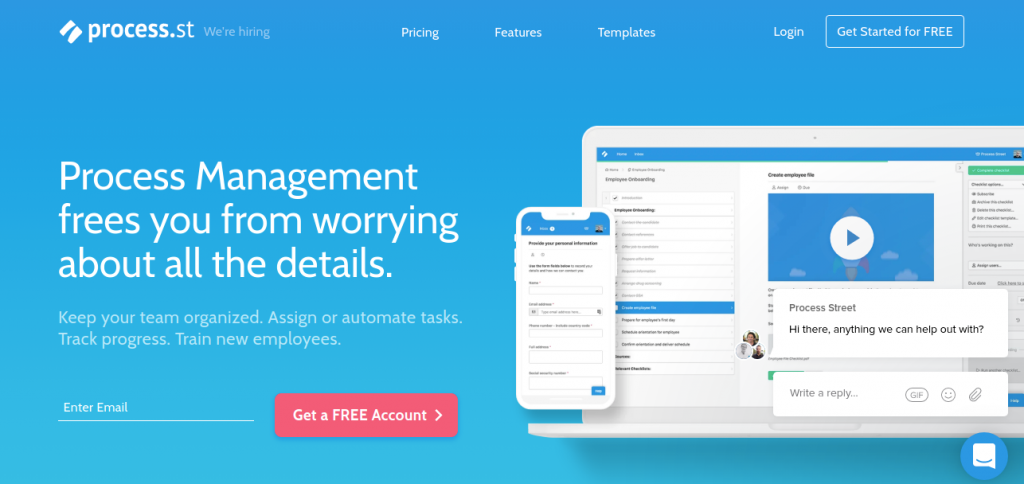
Process Street is a simple yet robust process and workflow management software. It is considered one of the simplest solutions teams can use to manage recurring workflows and checklists while working on projects. The software works for almost any team in any given work environment.
Why use Process Street?
With Process Street, businesses track their work processes using checklists, ensure minimal errors, and most importantly, save a lot of time. The software enables teams to create recurring checklists, collaborate on them seamlessly, and track them until they’re completed. Moreover, it offers a range of advanced add-ons like custom permissions, automation, and reporting that help businesses achieve more than what was expected.
Process Street pros
- Process routing
- Document generation
- Process design
- Data unification
- Task scheduling
Process Street cons
- Lack of templates
- Reporting tools only focus on checklist due date
- No permission to set on subfolders without affecting the main folder
Process Street rating
- G2 – 4.6 out of 5
- Capterra – 4.7 out of 5
Process Street pricing
Process Street offers two subscription plans and one free plan.
- Free
- Pro – Costs $25 per month per user.
- Enterprise – Connect with the Sales team to know the pricing
8. Backlog
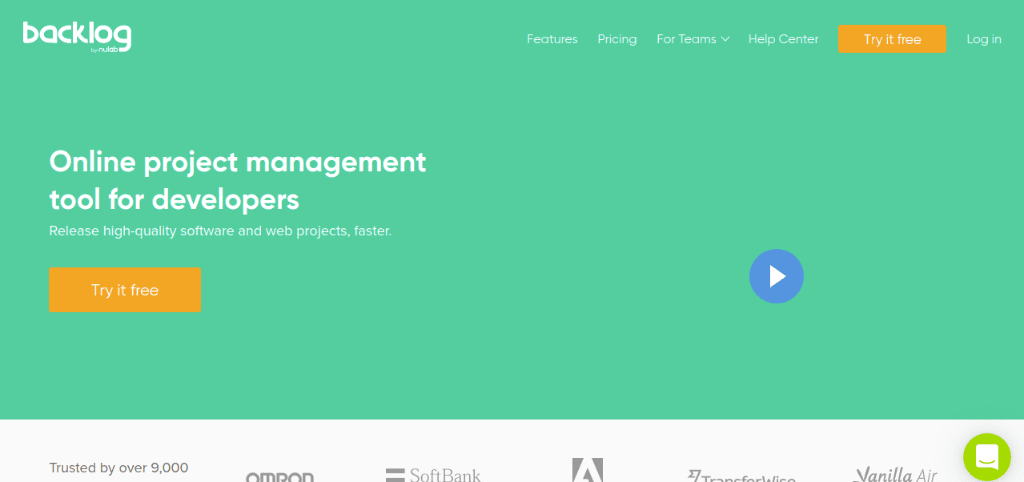
Backlog is a work management software specifically designed to meet the needs of development teams. The software practically covers every aspect of the software development process. With Backlog, managers and teams (non-tech and developers) can boost collaboration, communication, and coordination during the development process. If you wish to get a firsthand experience with the platform, you can easily sign up for its free trial.
Why use Backlog?
With Backlog, you can keep all your tasks in a single location while being able to assign the same to others. You can have a clearer view of projects with the use of burndown and Gantt charts. Moreover, you can track the progress of the project by the system while sharing feedback with the team.
Backlog pros
- Task management
- Wiki documentation
- Custom workflows
- Release forecasting
- Time tracking
- Progress monitoring
- Bug History
- Data retention
Backlog cons
- Unnecessary page reloads
- Gantt charts do not allow link creation for dependencies and task rescheduling
- Free plan offers limited storage capacity
Backlog rating
- G2 – 4.5 out of 5
- Capterra – 4.5 out of 5
Backlog pricing
Backlog offers four different subscription plans.
- Free
- Starter – Costs $35 per month.
- Standard – Costs $100 per month
- Premium – Costs $175 per month
9. nTask

nTask is an online workflow management solution that helps businesses of any size to get organized and streamline processes. This platform enables users to visualize the workflows across all the departments under different workspaces. It can be used for project planning, time tracking, issue management, and managing timeline using Gantt charts.
Why use nTask?
The ease of use and affordability make this solution a go-to workflow management platform for SME’s and small businesses. Several organizations use nTask to collaborate with their project teams, assign tasks, and get projects done promptly. It offers third-party integrations that can help you to manage everything related to projects in a single window.
nTask pros
- Project management
- Team chat
- Task tracking
- Kanban boards
- Team management
- Meeting management
- Issue tracking
nTask cons
- UI is not intuitive
- Software takes time to load
- Less storage option in Free plan
nTask rating
- G2 – 4.4 out of 5
- Capterra – 4.1 out of 5
nTask pricing
nTask offers three subscription plans.
- Premium – Costs $4 per month.
- Business – Costs $12 per month.
- Enterprise – Contact nTask’s customer support team.
10. Intervals
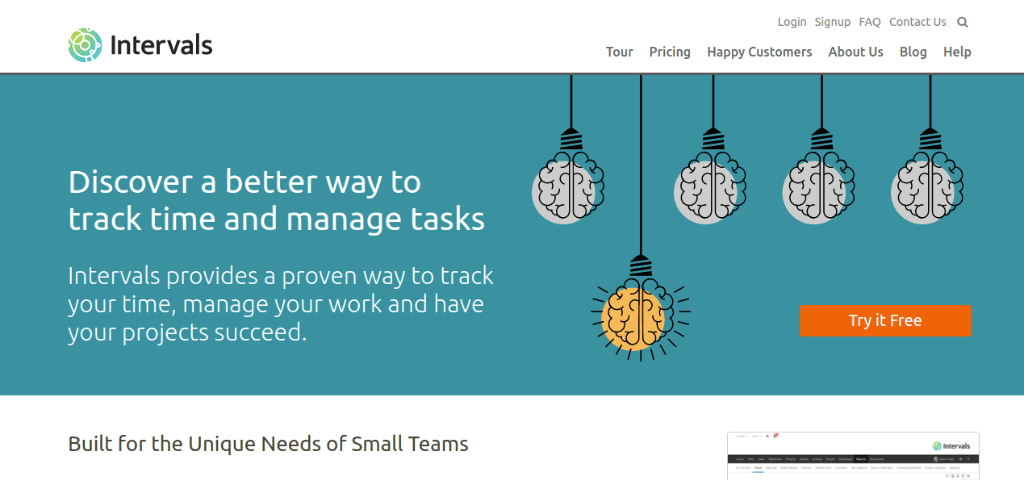
Intervals is a software solution that offers a mix of work and time management features to help project managers and teams better manage their projects. It gives project managers the ability to streamline all project processes, track productive work hours, and improve project team communication. Intervals stand out in the market for its exceptional project management, workflow management, client management, and analytics functionalities making it the best workflow solution.
Why use Intervals?
With Intervals, project managers can be sure that their team is always on the same page. They’re even able to approve timesheets, create invoices, and monitor project progress for individual team members. In addition to all the typical management and collaboration features, Intervals has quite an incredible support system. Plus, the software is available in a variety of pricing models that work for almost every business, no matter their size or type.
Intervals pros
- Custom workflows
- Kanban boards
- Time tracking
- Report scheduling
- Activity feed
- Lightweight CRM
- Accounting features
- Mobile app
- 3rd party integrations
Intervals cons
- Does not have the option to track time with start/stop times
- No options to set alerts for a specified date and time
- No option to restrict users to set only allowed task statuses
Intervals rating
- G2 – 3.9 out of 5
- Capterra – 4.5 out of 5
Intervals pricing
Intervals offer a whopping 7 subscription plans to cater to the needs of different business teams.
- Lite – Costs $29 per month.
- Basic – Costs $49 per month.
- Not So Basic – Costs $69 per month.
- Professional – Costs $99 per month.
- Premium – Costs $159 per month
- Top Shelf – Costs $219 per month.
- Unlimited – Costs $299 per month.
Note: Each of these plans also offers the standard features of Intervals.
11. Automate.io
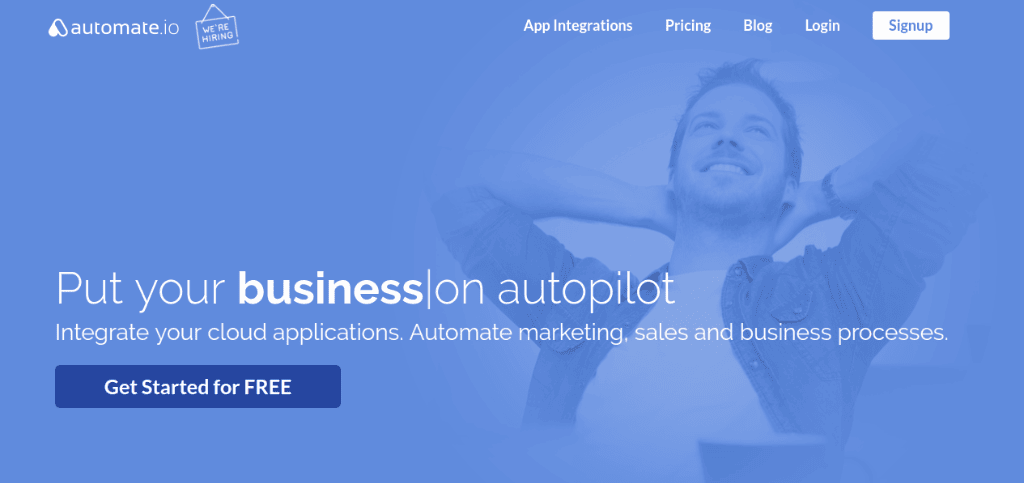
Automate.io is similar to other workflow automation tools you will find in the market, except for the fact that it allows you to create one-to-one integrations and multi-step workflows between multiple apps. The software is ideal for teams that are looking to customize their workflow in the way that best fits their needs while connecting and communicating effectively.
Why use Automate.io?
In Automate.io, integrations are available with an array of tools that professionals use daily – that includes CRM, lead generation software, and plenty of other business productivity apps. It also offers a free version where users can create five automation that will sync up to 250 actions each month. For more automation and actions you can go for paid plans that are available for $25, $49, and $99 per month.
Automate.io pros
- Multiple data sources
- Cost management
- ETL
- Web services
Automate.io cons
- Integrations are hard to implement
- Failure of automation triggers
- Difficulty moving documents out of Docusign to Google Drive
Automate.io rating
- Capterra – 4.6 out of 5
Automate.io pricing
Automate.io offers six different subscription plans depending on the needs of your business team.
- Free
- Personal – Costs $9.99 per month.
- Professional – Costs $29 per month.
- Startup – Costs $49 per month.
- Growth – Costs $99 per month.
- Business – Costs $199 per month.
12. Gravity Flow
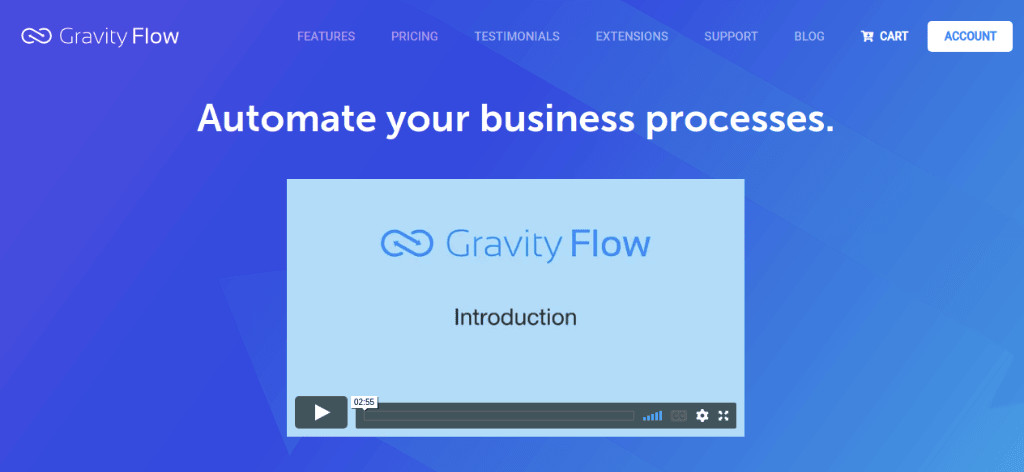
Gravity Flow is a popular workflow management tool that works with Gravity Forms (a WordPress plug-in used to create contact and lead generation forms). The software allows you to create multi-step workflows easily and quickly. Gravity Flow makes a great choice for web-based businesses and teams, especially those focusing on marketing and driving visitors online.
Why use Gravity?
The workflows created with Gravity Flow are ideal for leveraging existing marketing with an easy-to-use form builder and workflows to move information into your CRM and other marketing tools. In addition to that, Gravity Flow helps to stop micro-management. It helps teams to keep everyone in the loop and makes it easy for everyone (managers, teams, and clients) to participate in the workflow.
Gravity Flow pros
- Option to add unlimited users and workflows
- Smooth business process automation
- Detailed reporting
- Custom workflows
- Data privacy compliant
Gravity Flow cons
- Additional plugins are required to get features not part of Gravity Forms
- Setup process is a bit challenging
- Unintuitive controls
Gravity Flow rating
- Capterra – 4.6 out of 5
Gravity Flow pricing
Gravity Flow has three licensed plans.
- Core License – Costs $99 per year.
- Pro License – Costs $299 annually.
- Ultimate License – Costs $447 per year.
13. Nifty
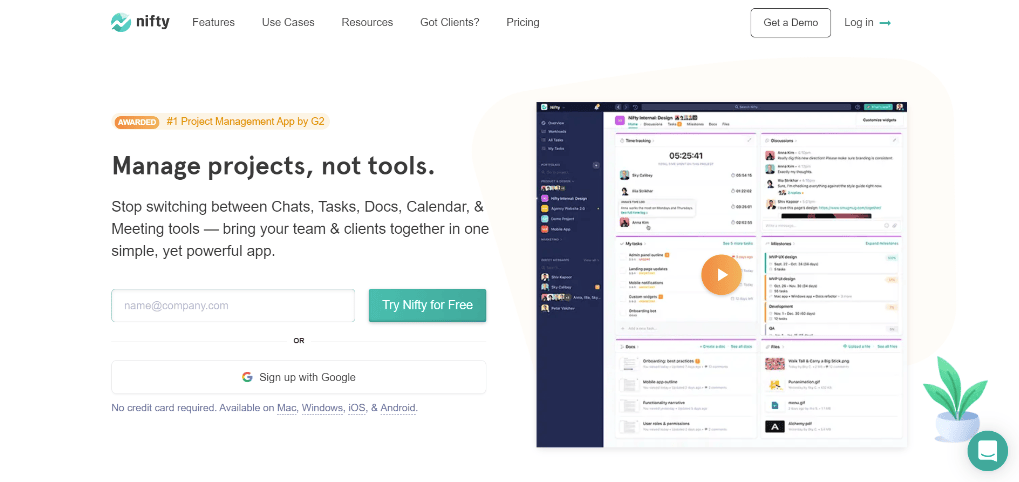
Nifty, just like the name suggests, acts as a nifty way to manage projects and every cluttered aspect of your work quite efficiently. It helps teams unite, collaborate, and come together to work on prioritized tasks on the same platform. It is easy to use and provides users with an agenda-driven approach to handling work assignments and delivering projects.
Why use Nifty?
What makes Nifty better than most workflow management software platforms is the fact that it helps manage time by allowing you to schedule everything on the same platform. It allows you to manage your tasks by navigating through a calendar view. It helps schedule meetings, tasks, and events, and along with all that, it helps teams stay goal-oriented with defined agendas and milestones.
Nifty pros
- Task management
- Project tracking/reporting
- Collaboration tools
- Time & Expense tracking
- Idea management
- Resource management
- Milestone tracking
Nifty cons
- Lack of document markup features like highlighting and commenting
- Database management and recording of user data suffer from duplication
- Unprofessional customer support team
- Chat option only for account admin
Nifty rating
- G2 – 4.7 out of 5
- Capterra – 4.7 out of 5
Nifty pricing
Nifty offers 5 different subscription plans.
- Free
- Starter – Costs $39 per month.
- Pro – Costs $79 per month.
- Business – Costs $124 per month.
- Unlimited – Costs $399 per month.
14. Trello

Trello is an advanced workflow software that uses intuitive features and an interactive interface to help teams get their tasks done. With elaborate Kanban boards, colorful task cards, expressive labels, and tags, a team could simplify all of their to-do items all at once. There are a lot of benefits to adopting Trello as your workflow assistant.
Why use Trello?
Trello is a great platform to get things sorted. It helps drive productivity through organization and helps teams work smart rather than hard. It takes away all the distractions and helps you keep your eye on the ball with the help of intuitive Trello boards, lists, task cards, assignments, and readily available productivity metrics.
Trello pros
- Task Management
- Project Planning
- Task Dependencies
- Task Prioritization
Trello cons
- Option to share confidential documents is not available
- Automation process is not easy to understand
- Integrating Excel with Trello is not easy
Trello rating
- G2 – 4.2 out of 5
- Capterra – 4.5 out of 5
Trello pricing
Trello offers 4 subscription plans.
- Free
- Standard – Costs $5 per user per month.
- Premium – Costs $10 per month per user.
- Enterprise – Costs $17.50 per user per month.
15. GoodDay
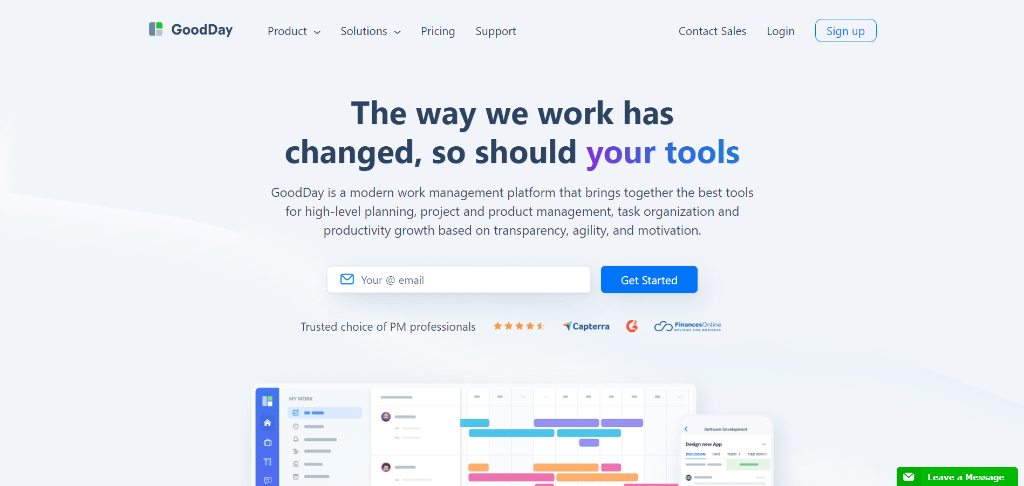
GoodDay is an excellent workflow management software that can be used to keep things sorted, track progress, and manage time effectively. It helps teams collaborate through Kanban boards and descriptive tasks. It is a software platform that will help you visualize your whole work process as a whole and drive collaboration through timely updates and descriptive notifications.
Why use GoodDay?
GoodDay is a great project management software that presents an impermeable workflow management system to help teams centralize information and collaborate in real-time. It helps streamline the planning process through easy-to-navigate workflows and project dependencies. It will help you define milestones and set recurring tasks. Additionally, it helps you create a product backlog for all your projects so that you can organize, edit, modify, and manage your priorities in an orderly manner.
GoodDay pros
- Task management
- Issue management
- Client portal
- Customizable templates
- Project planning/scheduling
- Resource management
GoodDay cons
- Mobile view is a bit slow in comparison to desktop view
- Lags behind in sending out alerts and notifications for tasks
- Initial load time is high
- UI lacks simplicity
GoodDay rating
- G2 – 4.3 out of 5
- Capterra – 4.7 out of 5
GoodDay pricing
GoodDay offers three subscription plans.
- Free
- Professional – Costs $4 per month per user.
- Enterprise – Connect with GoodDay’s customer support team.
16. ProWorkflow
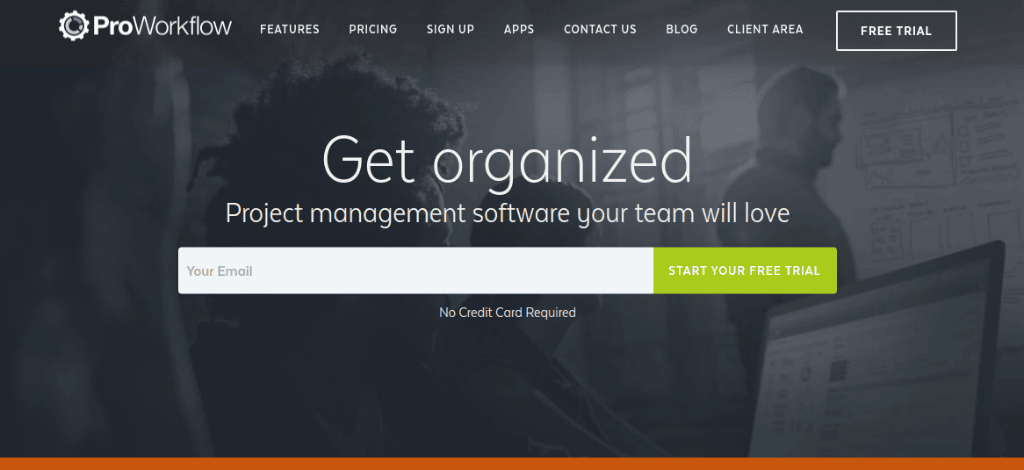
ProWorkflow is a workflow management tool that primarily focuses on visibility and control. It gives teams a quick overview of active, finished, and future work. The tool also features a simple drag-and-drop interface, one-click replies, Gantt style timeline, timesheets, etc that allow teams to get better control over their tasks and projects.
Why use ProWorkflow?
ProWorkflow offers a dedicated mobile application for Android, iOS, and Blackberry users, allowing them to access all its standard features like team messaging, time tracking, task management, etc from any device or location. Plus, it’s an open API system – which means it can virtually connect with popular third-party business applications without any hassle.
ProWorkflow pros
- Project management
- Resource management
- Collaboration tools
- Time & Expense tracking
- Client Portal
- CRM
ProWorkflow cons
- No option to duplicate the current project for recurring tasks
- No reporting permissions on a client-level
- Lack of more automation features
ProWorkflow rating
- G2 – 4.1 out of 5
- Capterra – 4.5 out of 5
ProWorkflow pricing
ProWorkflow offers 2 subscription plans.
- Professional – The professional plan costs $20 per month per user.
- Advanced – The Advanced plan costs $30 per month per user.
17. Zapier
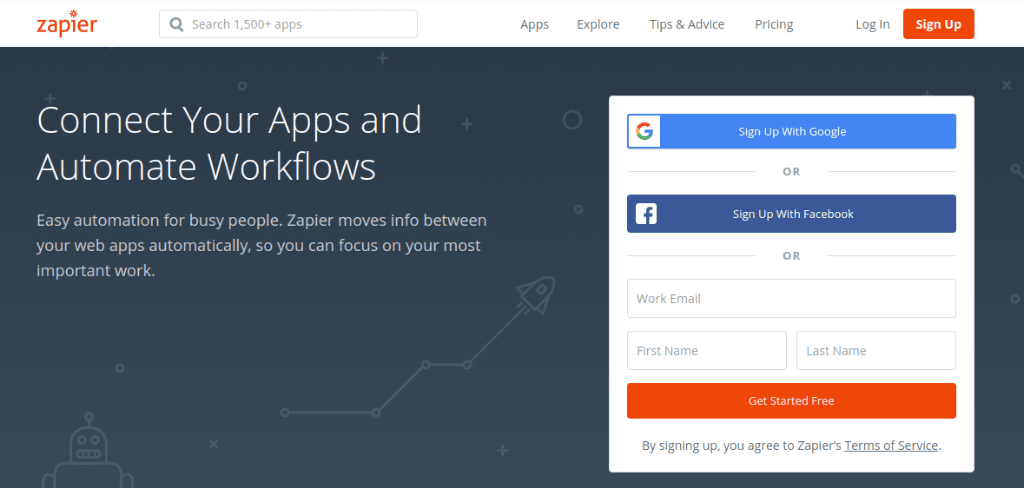
Zapier is a web-based solution that enables companies to connect various applications to automate workflow and boost productivity. It provides the right set of tools to teams so that they can accomplish more with less effort and errors.
Why use Zapier?
What makes Zapier unique is its lean but capable dashboard that lets teams manage apps and zaps easily. It creates systems and processes that let teams do what they are best at doing. It simplifies the way data moves between different web pages so that teams can focus on things that matter.
Zapier pros
- Task management
- Business process automation
- Real-time integration
- Data encryption
- Data mapping
Zapier cons
- Some 3rd party integrations have poor support
- Collaboration is not available on the Professional Plan
- Business plans are quite expensive
Zapier Rating
- G2 – 4.5 out of 5
- Capterra – 4.7 out of 5
Zapier pricing
Zapier offers 5 subscription plans.
- Free
- Starter – Costs $19.99 per month.
- Professional – Costs $49 per month.
- Team – Costs $399 per month.
- Company – Costs $799 per month.
18. Pipefy
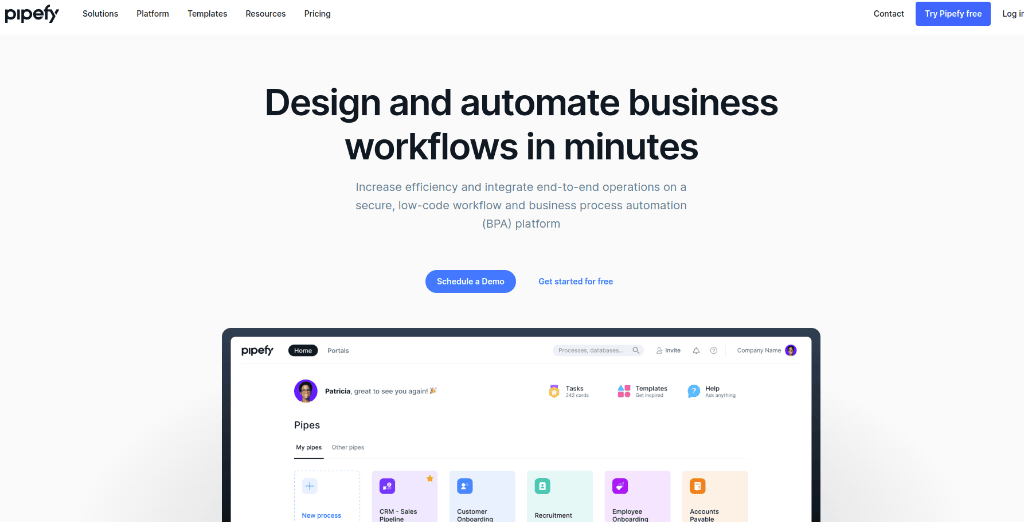
Pipefy improves workflow efficiency and integrates end-to-end business operations using a safe business process automation platform. It is an efficient task management workflow tool that helps organizations handle daily business processes like purchases, job openings, accounts payable, and employee onboarding.
Managers can do all this through automated workflows, better visibility, and increased speed to deliver better results.
Why use Pipefy?
Pipefy helps businesses accelerate their digital transformation. It is a business process management platform that automates workflows without the need for coding skills.
Pipefy pros
- Business Process Management Automation
- Conditional Logic
- Built-In Calendar
- Two-Factor Authentication
- E-Mail messaging
Pipefy cons
- No free trial
- Pricing plans are per-user
- No Gantt charts
Pipefy rating
- G2 – 4.6 out of 5
- Capterra – 4.6 out of 5
Pipefy pricing plans
Pipefy offers a free-of-cost Starter plan for small teams, startups, and students who want to organize their tasks. Besides this, Pipefy offers 3 subscription plans.
- Business – Costs $19 per month per user.
- Enterprise – Costs $32 per user per month.
- Unlimited – Connect with the customer support team to know the pricing.
19. Integrify
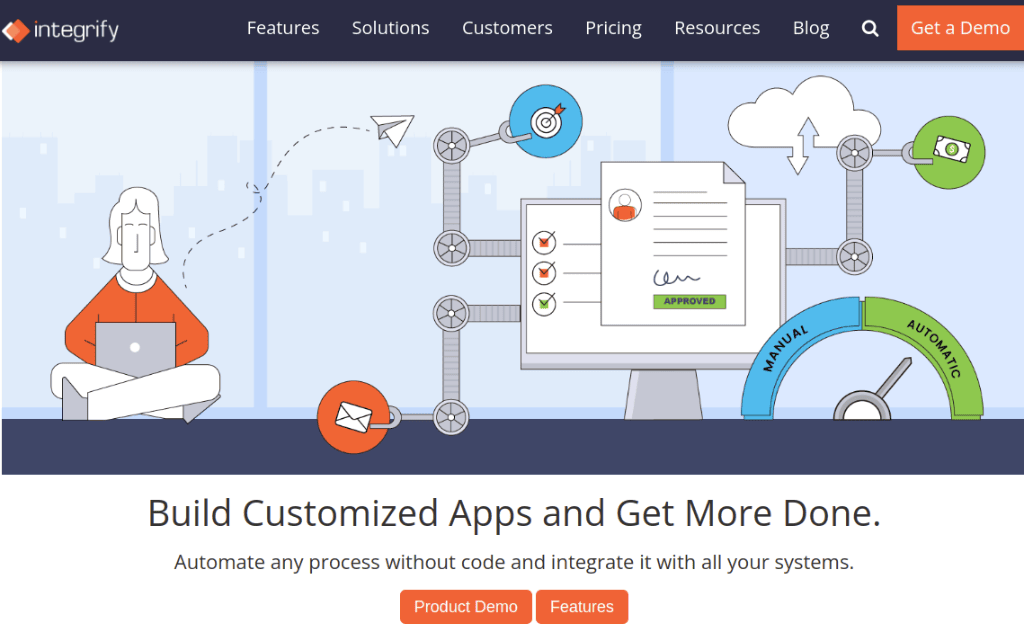
Integrify is a business project workflow management software that helps you build active web forms and route daily workflow. Integrify also offers automation for team-specific workflow.
Why use Integrify?
Integrify is suited to mid-sized and large organizations looking to reduce costs and improve business process management efficiency. It helps businesses automate workflow and visibility in IT, HR, Sales, Finance, and Operations.
Integrify pros
- Unlimited audit trails
- Self-Service portal designer
- Mobile Access
- API Integration
- Customized notifications, reminders, and escalations
- Approval/Actions by Email
Integrify cons
- Not that intuitive or easy to understand
- Complicated workflows/processes
- Lack of manual saving
Integrify rating
- G2 – 4.4 out of 5
- Capterra – 4.6 out of 5
Integrify pricing
To know the subscription plans for Integrify, you need to connect with their customer support team.
20. Flokzu
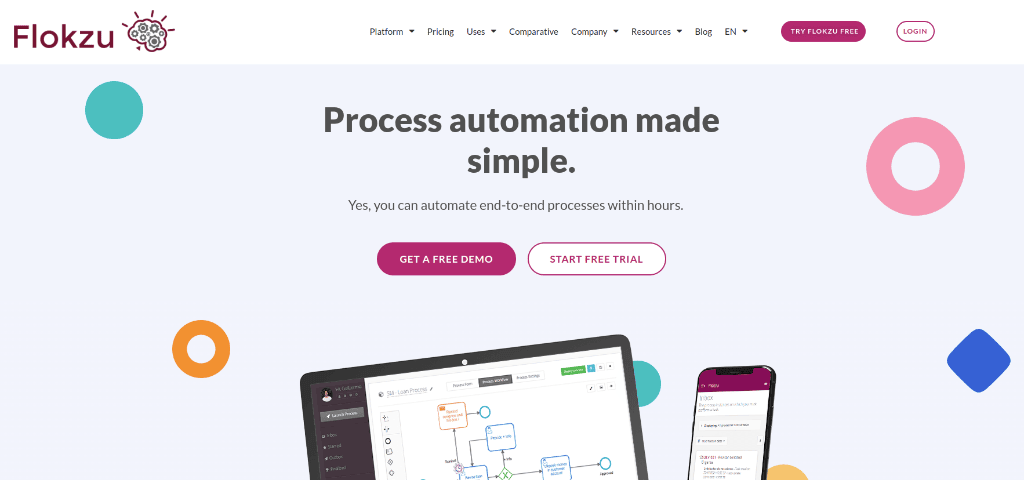
Flokzu is a cloud-based workflow software that lets businesses create templates. It also comes with automation features for improved workflow productivity. Some of these features include customized reports, reminders, form builders, and easy flowcharts among others.
Why use Flokzu?
Flokzu makes it possible for organizations to have all their documents and tasks in one place. It helps businesses customize their workflow to reduce time and effort. Flokzu makes it easy to search documents fast, measure processes, and keep all sensitive data in one place.
Flokzu pros
- Social collaboration tools
- Custom reports
- Sandbox for process testing
- Support for modeling languages
Flokzu cons
- No Free version
Flokzu rating
- G2 – 4.9 out of 5
- Capterra – 4.8 out of 5
Flokzu pricing
Flokzu offers 4 different subscription plans.
- PoC – Costs $50 per month (billed yearly).
- Standard – Costs $14 per month (billed yearly).
- Premium – Costs $20 per month (billed annually).
- Enterprise Custom – Connect with Flokzu’s sales team.
21. Adobe Workfront
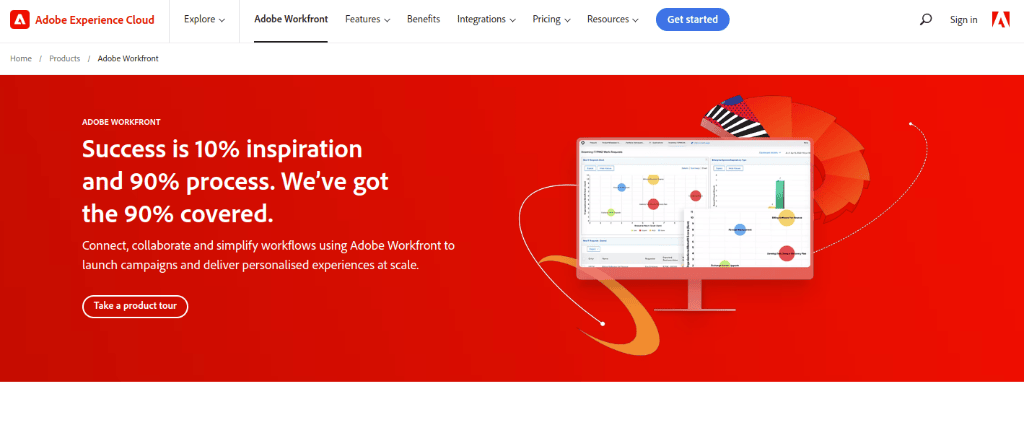
Adobe Workfront is a good workflow process management software that is best for agencies, IT departments, and marketing professionals.
Workfront removes the gap between work strategy and delivery, integrates employees and data across the enterprise, and makes work management smooth and easy. Adobe Workfront helps organizations deliver an exceptional customer experience.
Why use Adobe Workfront?
Adobe Workfront makes it easier for businesses to get over excessive email threads, redundant status meetings, and disconnected business management tools.
Adobe Workfront pros
- Streamlines business’s marketing processes
- Offers real-time and accurate information to IT teams
- Helps creative teams deliver quality work
- Eases product development and management
- Helps deliver projects on time and with quality
Adobe Workfront cons
- Not easy to learn for new users
- Time-consuming setup
- Hard to understand Gantt charts
Adobe Workfront rating
- G2 – 4.1 out of 5
- Capterra – 4.3 out of 5
Adobe Workfront pricing
Adobe Workfront offers three subscription plans – Pro, Business, and Enterprise. However, you need to connect with their customer support team to know the prices.
22. Zoho Creator
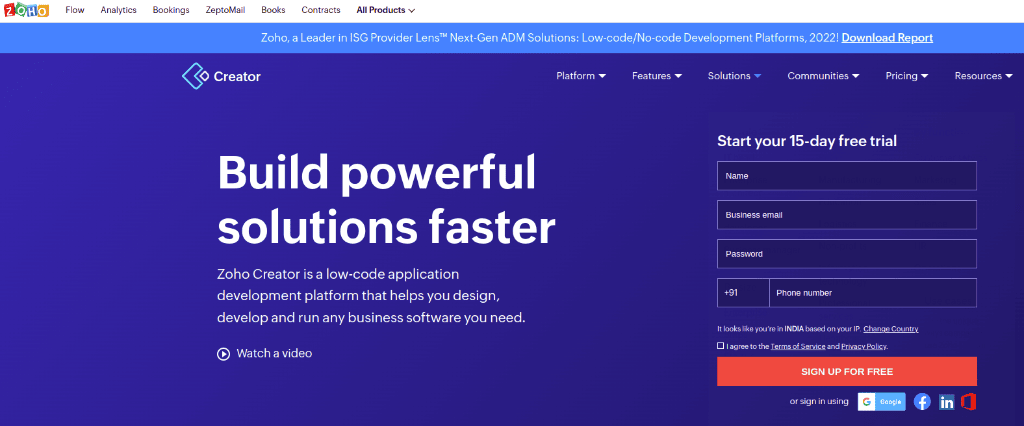
Zoho Creator is a workflow automation software for businesses. This helps business teams create custom workflows, streamline communication, and automate repetitive tasks.
Why use Zoho Creator?
Zoho Creator helps team managers automate daily workflow and create business process automation scripts. Process automation also helps team leaders remove unnecessary and manual overhead tasks.
Zoho Creator pros
- Free Trial
- Easy Drag-and-Drop interface
- Email notification & scheduling
- Data import/export
- Real-time reporting
Zoho Creator cons
- Expensive
Zoho Creator rating
- G2 – 4.3 out of 5
- Capterra – 4.3 out of 5
Zoho Creator pricing
Zoho offers three subscription plans – Professional, Ultimate, and Enterprise
- Basic – The Basic plan costs $10 per user per month
- Premium – The Premium plan costs $30 per user per month
- Ultimate – You can avail the Ultimate plan only in the yearly plan
Why should you use a workflow management tool
Now that you are all familiar with the most intuitive, robust, and reliable workflow tools in the market, you must understand why you must have one.
The workflow management system you choose to use will be an advanced platform that will help you improve the way you work. It gives you the ability to create and optimize your work processes in an ideal way, find redundant tasks and roadblocks, identify potential areas of improvement, and achieve new levels of efficiency.
So make up your mind, because when you are in the market for a work management tool, look for a product that allows you to:
- Manage work the way you want
- Create custom workflows
- Make task management easy
- Define stages and move tasks into stages
- Integrate workflow with every task list
- Streamline repetitive processes
- Allow creating and assigning tasks
- Create stages in which tasks can be defined and moved
- Synchronize tasks in every stage
- Follow up on tasks in the process
- Adapts to changes along the way
and more.
Conclusion
To handle so much every day, team managers and business owners have to wear multiple hats. Workflow management software makes it easier for them to do this by taking away redundant tasks and helping them focus on what’s important.
Workflow Management Software FAQs
What does a workflow management software do?
The workflow management tool offers you an organized way to document, monitor, and handle daily workflow to complete a task efficiently.
What is the best workflow management software?
If you are looking for a workflow management system that offers project management and team collaboration, ProofHub is the best workflow management software for you.
What are the 3 basic components of workflow?
Input (resource to start a workflow), Transformation (how input is received and what happens afterward), and Output (Final product) are the 3 basic components of a workflow.
